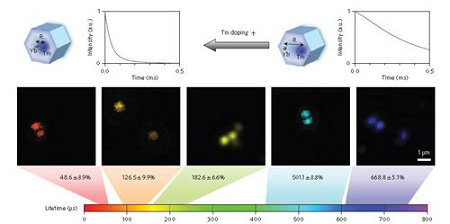Peking University and Australian and American scientists join forces to create a new optical coding mechanism
Recently, the research team of Xi Peng, a research fellow of Peking University School of Engineering, and the research group of Professor Dayong Jin of Macquarie University in Australia and the research team of J Paul Robinson of Purdue University jointly developed a series of up-conversion nanocrystalline particles with adjustable luminescence lifetime Ï„-dot can use its fluorescence lifetime to realize a new optical encoding of time dimension.
Traditional fluorescent labels use color coding to realize the staining of different organelles, and then study the molecular mechanism of disease. However, due to the serious overlapping of the colors of the fluorescent lights, the available coding amount is very small, and the characteristics that can be recognized are very limited. Although quantum dots partially alleviate this problem by narrowing the fluorescence spectrum, because the physical mechanism is still marked by color (spectrum), the amount of coding cannot be substantially improved. Encoding from other spatial and temporal dimensions is the key to solving this problem.
The newly developed nanoparticles can achieve continuously adjustable high-precision coding from tens to hundreds of microseconds. Nano-sized particles with different lifetimes can be quickly and accurately identified by the time-resolved laser confocal scanning microscope and scanning cytometer system they jointly developed and developed. Previous researchers focused more on color separation and imaging with fluorescence lifetimes in the nanosecond range, resulting in a low number of codes. Based on the new time-coding dimensions provided by up-converting nanoparticles, the new Ï„-dot opens a brand-new application space for multi-channel biological imaging, high-throughput single-cell quantitative detection, high-density data storage, and file security coding. Relevant achievements were published in the form of express in Nature Publishing Group's "Nature-Photonics" and published online recently.

Xi Peng's specially appointed researcher once conducted postdoctoral research under the guidance of Professor J Paul Robinson at the Flow Cytology Laboratory of Purdue University. The research areas of Xi Peng's research group include super-diffraction limit resolution micro-imaging, laser confocal scanning micro-imaging, multi-photon micro-imaging and optical coherence tomography. The Australian Advanced Cytometer Laboratory has been committed to the combination of optical time-resolved detection and rare earth molecular probes to achieve background-free, high-speed, high-quantum yield flow cytometry, slide cell detection, and rare events. technology.
This achievement is another major breakthrough after the super-sensitive single upconversion nanoparticle probes published in the "Nature-Nanotechnology" by the Jin Dayong research group of Australia and the Peking University Xi Peng research group two months ago. The history of cooperation between the two research groups can be traced back to 2010, and 9 articles have been published in internationally renowned journals.
Skin Care Set,Skincare Gift Set,Skincare Kit,Skincare Gifts
Guangzhou cosmeceuticals daily chemicals PTY,.LTD. , http://www.guangzhoucosmetics.com